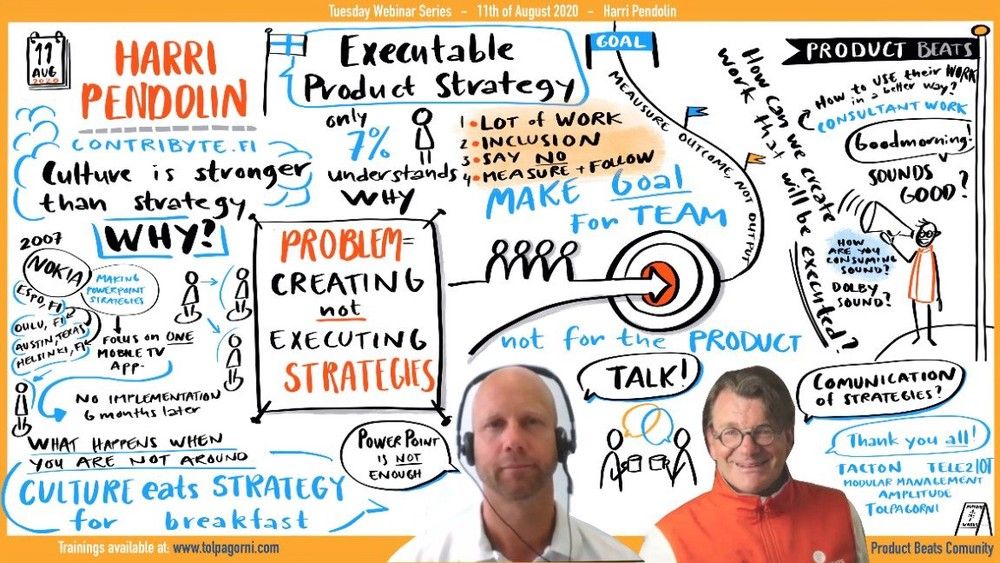Episode 20: Executable Product Strategy w/Harri Pendolin
11 August, 2020 / Host: Magnus Billgren
How to Create an Executable Product Strategy
In today's fast-paced and ever-changing business landscape, it's becoming increasingly difficult for companies to create and execute effective product strategies. While many organizations can develop innovative product ideas, they often struggle to follow through with their plans, resulting in missed opportunities and wasted resources.
In this episode, Harri Pendolin, a lead consultant in product and portfolio management, discusses the importance of executable product strategies and how culture can affect the execution of a strategy.
The Need for Executable Product Strategies
According to Pendolin, the key problem facing companies is not creating a strategy, but executing it. He highlights a statistic that only 7% of employees fully understand their company's business strategies, which is a clear indication that there's a disconnect between a company's vision and its execution.
Pendolin explains that an executable product strategy must be clear, concise, and easily understood by everyone in the organization. The strategy should also be flexible enough to adapt to changes in the market and technology. He notes that the lack of an executable product strategy can result in companies pursuing too many initiatives, which can lead to a failure to execute effectively.
The Importance of Culture
Pendolin also highlights the impact that company culture can have on the execution of a product strategy. He stresses that a culture that values execution is critical to success. A company's culture should encourage transparency, accountability, and experimentation. Employees must be empowered to make decisions, take risks, and learn from their mistakes. This creates a culture of innovation and allows the organization to move quickly and make decisions that drive business success. He suggests asking questions like, "Is the culture aligned with the strategy? Do we have the right people in the right roles? Are our processes and systems supporting the strategy?" This will help identify any potential roadblocks and ensure that the strategy is executable in practice.
How to Implement an Executable Product Strategy
Pendolin advises that an executable product strategy should include the following:
- Clearly Defined Goals: The product strategy should define clear and measurable goals, so the company knows what it's working towards.
- Product Portfolio Management: Companies should have a clear view of their product portfolio, including the development of new products, enhancements to existing products, and the retirement of outdated products.
- Product Roadmaps: A product roadmap outlines the timing and sequencing of product initiatives. It should align with the company's overall strategy and provide clarity on how the product will evolve over time.
- Agile Methodology: Agile methodology is a project management approach that emphasizes flexibility and adaptability. It can help companies respond quickly to changes in the market and technology.
- Performance Metrics: Measuring the success of a product strategy is critical to its execution. Companies should use performance metrics to evaluate their progress and identify areas for improvement.
Tools for Enhancing Strategy Execution
In addition to creating an executable product strategy and aligning culture, there are two relevant tools to enhance strategy execution:
- Strategy Creation Framework: This is a methodical approach to creating a strategy that is easy to understand and executable in practice. It involves identifying the company's core values, assessing the market and competition, defining the target audience, setting goals and objectives, and outlining the tactics needed to achieve them. The framework can be applied to any industry or organization size.
- Speed Layers: This tool involves breaking down the strategy into smaller, more manageable parts. By dividing the strategy into "speed layers," organizations can focus on the most critical components first and gradually work towards achieving the overall objective. This approach ensures that the strategy is executable in practice and that progress is made regularly.
Takeaways
- The success of a product strategy lies not in its content, but in its execution. It is essential to think about execution as you create the strategy.
- Culture plays a vital role in the execution of a product strategy. Even the best strategy can fail if the company culture does not support it.
- Investing in product management and methodology training can help product organizations and teams to better execute their product strategies. It is crucial to ensure that all employees fully understand and are aligned with the strategy to increase the chances of successful execution.
Now that we've explored the importance of having an executable product strategy and the tools that can help enhance its execution, it's clear that having a solid foundation in product management is critical to success in this field. This is where The Productbeats Product Management Certification Program comes in. If you're looking to expand your knowledge and skills in product management, this program can provide you with the training and certification you need to excel in this field. Let's take a closer look at what this program has to offer.
You might also enjoy watching...
Copyright © 2023 ProductBeats AB

Get The Program Brochure
Submit the form below to have The Program Brochure delivered to your inbox
The title of the notification
The descriptive text of the notification


